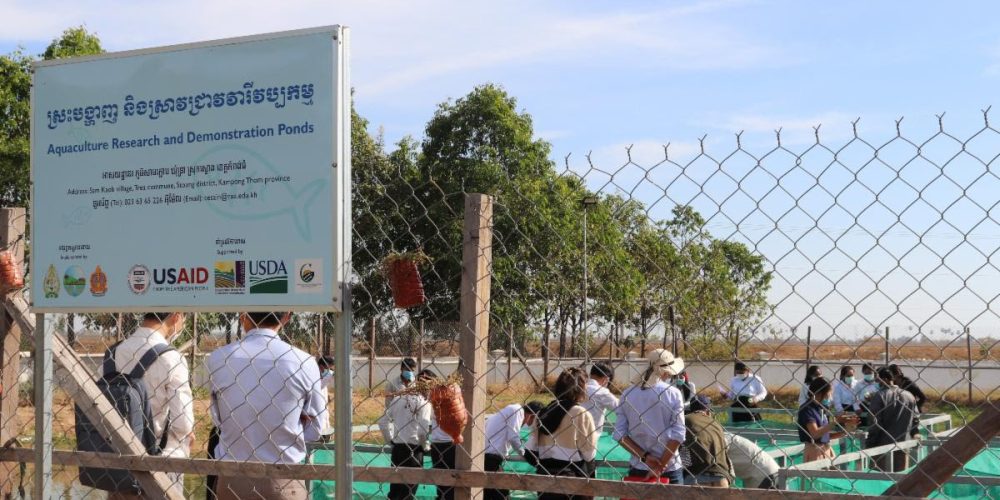ASA/WISHH, Kansas State University (KSU) and Cambodian partners have collaborated to produce new fish feeding and growth charts. These vital new tools will assist Cambodian fish farmers in their transition from homemade feeds based on rice bran and wild fish to pelleted soy-based feeds manufactured in Cambodian feed mills.
“WISHH multiplies the value of U.S. government programs through our strategies that also benefit from the support of U.S. soybean growers,” says WISHH Executive Director Liz Hare. “We appreciate the cooperation of all our partners in the United States and developing and emerging countries in Asia, Africa and Central America.”
Commercialization of Aquaculture for Sustainable Trade (CAST) – Cambodia is ASA/WISHH’s USDA-funded Food for Progress project that benefits from KSU’s expertise and work with the Center of Excellence on Sustainable Agricultural Intensification and Nutrition (CE SAIN) at the Royal University of Agriculture (RUA). KSU also is the lead for the U.S. Agency for International Development (USAID) Feed the Future Innovation Lab for Collaborative Research on Sustainable Intensification (SIIL).
CE SAIN, funded through SIIL at KSU, provides training for the CAST project. Due to both USDA and USAID investments, there is a collaboration between these organizations to promote aquaculture opportunities in Cambodia.
“These feed and growth charts for each species will enable Cambodian farmers to transition to soy-based feeds so they can be more certain of turning a profit,” said global aquaculture expert Karen Veverica, a consultant for CE SAIN on the CAST project. “Both charts will provide a practical tool that can be valuable, not only for fish famers across Cambodia, but for the feed companies as well.”
For decades, most Cambodian fish farmers have made their own fish feed from rice bran and wild-caught fish. The practice has led to overfishing, and a resulting rise in the price of the wild-caught fish. The homemade feed is also very low in protein so farmers are used to pouring large amounts of feed daily into ponds. As farmers transition to factory-made feeds, these feeds are more nutrient-dense, and therefore, less is needed to achieve the same growth. However, the price of factory-made feed is higher on a per kg basis. If farmers continue to feed the same amounts, they will lose money and go back to using the wild-caught fish. Therefore, CAST partners developed these feeding and growth charts for two species of fish in Cambodia, the climbing perch and the hybrid catfish.
These feed charts will assist the farmers in knowing what size and type of feed to use and how much to feed as the fish continue to grow. As a result, CAST is developing a market for soybean meal to be used in Cambodian fish diets.
KSU collaborates with Cambodian researchers, policymakers, donors and aquaculture industry representatives who participate in CE SAIN’s initiatives. With USAID funding, KSU has established the Agricultural Technology Park in Kampong Thom and Battambang provinces, which provides a demonstration site for current and future fish farmers of Cambodia. An additional demonstration pond is located at RUA in Phnom Penh.
In addition to the benefits these feed and growth charts will provide fish farmers, it is also a great opportunity for the young technicians to collect valuable data on water quality variables that can be used in future training programs. The technicians will gain understanding of how water quality such as dissolved oxygen, pH and ammonia change over the production cycle. The agricultural technology parks provide tremendous hands-on learning experiences.
Lyda Hok, the director of CE SAIN and faculty member at RUA said “Not only is this a great tool for the Cambodian fish farmers to use to enhance their feeding techniques and fish diets, but the research with this CAST project is an excellent training opportunity for technicians and it offers an invaluable learning experience.”
A USDA-funded project, CAST is designed to accelerate production of high-demand fish species for the Cambodian market and develop a lasting aquaculture industry. CAST strengthens local production of high-quality feed and fish. Through CAST, Cambodia’s private sector and universities work closely with U.S. soybean growers and businesses as well as academic and non-governmental organizations.
Photo Caption: New feeding charts will assist Cambodian fish farmers in their transition from homemade feeds based on rice bran and wild fish to pelleted soy-based feeds manufactured in Cambodian feed mills.

